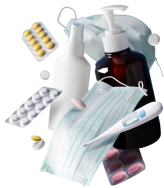Healthwire Pharmacy provides 100% genuine medicines straight to your doorstep.
Order Now! & Avail
Upto 10% OFF On All Your Pharmacy Orders!
Diclofenac diethylamine
Healthwire Pharmacy Ratings & Reviews (1500+)
Product Information
Diclofenac diethylamine gel is a topical nonsteroidal anti-inflammatory drug (NSAID) that works by inhibiting the cyclooxygenase (COX) enzymes, mainly COX-2. When applied to the skin, diclofenac penetrates the underlying tissues and reduces inflammation by blocking the production of prostaglandins, which are key mediators of pain and inflammation. This mechanism of action helps to alleviate pain and inflammation associated with various musculoskeletal conditions, such as arthritis and sprains, by directly targeting the affected area without significant systemic absorption.
Diclofenac diethylamine
Non-steroidal anti-inflammatory drug (NSAID)
Gel
The following are the uses of Diclofenac diethylamine Gel:
Tailoring Treatment for Optimal Health, Prescribed Medication Dosage is:
In the case of an overdose of Diclofenac diethylamine Gel, individuals may experience severe skin reactions at the application site, including redness, itching, and blistering. Systemic symptoms such as gastrointestinal distress, dizziness, and headaches can also occur. Promptly seek medical advice if an overdose is suspected, as healthcare professionals can provide guidance on managing symptoms and preventing potential complications. Timely intervention is essential to ensure appropriate treatment and minimize the risk of adverse effects.
In the case of a missed dose of Diclofenac diethylamine Gel, it is recommended to apply the gel as soon as you remember. However, if it's almost time for your next dose, skip the missed dose and continue with your regular dosing schedule. Do not apply extra gel to make up for the missed dose, as this may increase the risk of side effects. If you miss multiple doses, consult your healthcare provider for guidance on how to resume your treatment safely.
To apply Diclofenac diethylamine Gel, clean and dry the affected area, then gently massage a small amount of the gel onto the skin, covering the entire painful or swollen area, usually 2 to 4 times a day or as directed by your doctor.
Here are the situations when Diclofenac diethylamine Gel should not be used:
The side effects of Diclofenac Diethylamine Gel may include:
Following are the precautions and warnings for Diclofenac Diethylamine Gel:
Following are the drug interactions for Diclofenac diethylamine Gel:
Following are the food interactions for Diclofenac diethylamine Gel:
Diclofenac diethylamine gel should be stored in a cool and dry place, preferably at room temperature, ensuring protection from direct sunlight and moisture. The gel tube should be tightly sealed after each use to maintain its integrity and effectiveness. It is crucial not to freeze the gel and to keep it away from heat sources, as temperature fluctuations can impact its quality. Always check the expiration date, and if the gel has expired or is no longer needed, proper disposal is essential. Do not pour it down the drain or discard it with regular household waste; instead, follow local guidelines for pharmaceutical waste disposal or consult a healthcare professional for guidance on safe disposal methods. Keep the gel out of children's reach to prevent accidental exposure.
Following are the quick tips for Diclofenac diethylamine Gel:
It is crucial to monitor your health while taking Diclofenac Diethylamine 1% to ensure that the medication is working safely and effectively. To that end, your doctor may require you to undergo certain lab tests to check for changes and ensure that you remain in good health. These tests typically include a Blood Chemistry Profile, Liver Function Tests, Kidney Function Tests, Hemoglobin Concentration, White Blood Cell Count, and often Electrolyte Panels. The Blood Chemistry Profile assesses essential biomarkers in your blood like potassium, sodium, calcium, phosphorus, and chloride, ensuring that these levels are normal and your body's chemical balance is maintained while on the drug. Liver Function Tests assess the organ's function through liver enzyme levels (such as alanine aminotransferase (ALT) and aspartate aminotransferase (AST)) and bilirubin, which indicates liver health. These tests are crucial as Diclofenac can put stress on the liver, and cautions against any undue harm to this vital organ. Kidney Function Tests evaluate kidney function by measuring blood levels of creatinine and blood urea nitrogen (BUN). Since Diclofenac can be processed by the kidneys, these tests are important to monitor medication processing and eliminate it from the body. Hemoglobin Concentration tests monitor if enough oxygen reaches your organs and tissues and whether it indicates anemia, a condition that long-term use of nonsteroidal anti-inflammatory drugs like diclofenac can exacerbate. White Blood Cell Count measures the number of white blood cells, vital to your immune system. This test helps spot any signs of an immune disorder or infection. Electrolyte Panels evaluate levels of sodium and other electrolytes, maintaining nerve and muscle function and ensuring proper fluid balance in the body. These lab tests serve as a monitoring tool for your health care provider, aiding in the early detection of potential drug side effects or

Order Now! & Avail
Upto 10% OFF On All Your Pharmacy Orders!

If you face any issue, feel free to contact us. We provide 24/7 support to assist your problems